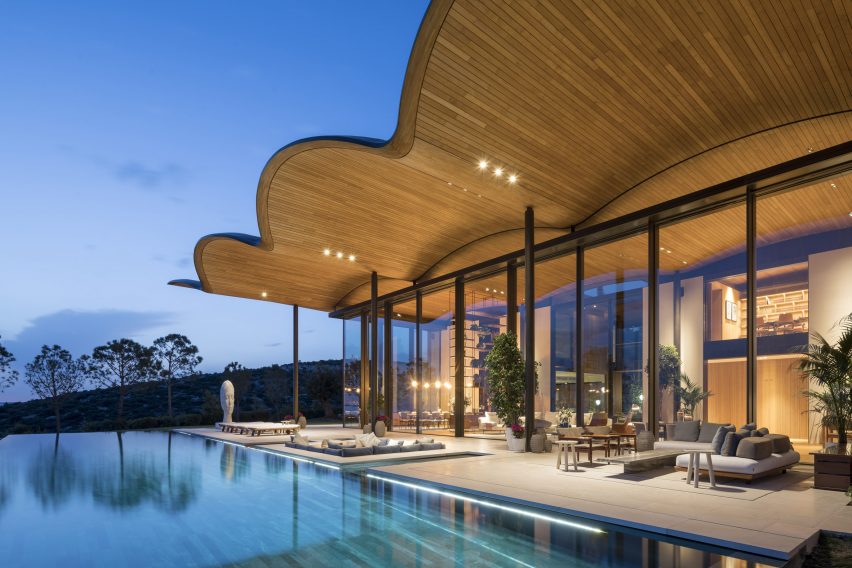Foster + Partners shelters Dolunay Villa in Turkey under giant undulating roof
A rippling timber roof cantilevers from the Dolunay Villa in Muğla, Turkey, designed by Foster + Partners to complement its rugged coastal setting.
Positioned on the coast of the Aegean Sea, it is the first private family house designed by Foster + Partners since completing Leedon Park House in Singapore in 2006.

Dolunay Villa's giant undulating timber roof is designed to appear like an extension of its rocky, beachside setting.
Its terraces are sheltered by the home's overhanging roof, which has a 7.5-metre-wide cantilever. It relies on solid structural oak beams that rest on steel columns and was designed in collaboration with Blumer Lehmann.

"We were fascinated by the local landscape and wanted it to flow through the interior spaces and effectively disguise the building," said Foster + Partners' head of studio David Summerfield.
"Even though it gets incredibly hot in the summer, we wanted the building to be able to breathe naturally," he added.
"The landscaped open courtyards within the house allow the prevailing sea breeze to gently move through the villa. These are simple ideas that have come together in an elegant way."

Huge areas of glazing on the south side of the home open out to the sea and invite in the coastal breeze.
Dolunay Villa comprises two storeys divided into private and shared spaces, surrounded by landscaped gardens. These gardens feature fragrant plants such as thyme and lavender, chosen to create a "multi-sensory experience".

The home is accessed from a meandering approach on its north side, where it is disguised as a closed-off, low-rise dwelling.
Its full scale is revealed by following the gradient of the sloped site to the south side, where it switches into a two-storey structure, partially embedded it into the landscape.

The unexpected transition between the one and two-storey sides to the villa is reflected externally in the buildings material finishes.
Its windowless north side is lined with stone and timber slats, while the south sea-facing side is enveloped by large areas of glazing.

"There's a real split between the public forum and private," explained the architecture firm's partner Niall Dempsey.
"A sense of discovery and a richness of experience comes through in the way the spaces change as you walk through the site."
Inside, the main entrance guides visitors directly to the centre of the villa, which is flanked by the private quarters on its east side, and the public areas to the west.

Here there is a feature spiral staircase that is made from solid Portuguese limestone, and provides access to the lower ground floor.
Along Dolunay Villa's south-facing facade, the glazing slides open to provides access onto shaded terraces.

These terraces offer an connect the interior and exterior, and also help naturally ventilate the home.
This main outdoor terrace links to the shared living areas, and is connected to a linear swimming pool.

Throughout the home, the interiors are complete with a natural material palette dominated by stone, wood, leather and bronze.
Many of its finishing touches are bespoke, including hand-carved solid timber doors and ceramic tiles and basins in the bathrooms.

The home is complete with a "sunset pavilion" positioned closer to the coast.
This pavilion also features an earthy material palette of stone walls, wooden tables and a bamboo soffit.

Foster and Partners is an architecture studio with offices worldwide and headquarters in London. It was founded in 1967 by Norman Foster.
Other recent projects by the studio include a luxury residential tower in London, Philadelphia's tallest building and an Apple store in Miami with an undulating white concrete roof.
Photography is by Nigel Young/Foster + Partners.